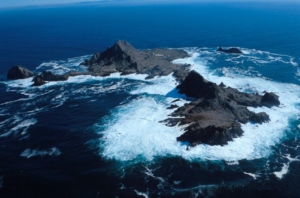Fighting for the Farallones
Environmentalists and wildlife advocates scored a major win earlier this month when California Governor Gavin Newsom signed AB1322, the California Ecosystems Protection Act of 2023, into law.
The law places a moratorium on diphacinone, a first-generation anticoagulant rat poison. It’s an expansion of a similar bill passed in 2020, which essentially banned second-generation rodenticides.
But even as we celebrate this new law and the wildlife, pets, and people it protects, there are a series of ecologically sensitive islands 27 miles off the coast of San Francisco under threat of another pesticide, brodifacoum.
In late 2021, the California Coastal Commission approved a plan to drop almost 3,000 pounds of grain containing brodifacoum on the Farallon Islandsto rid the islands of an infestation of non-native house mice.
For the past three years, ever since the commission began considering this course of action, I have made it a point to speak up during the public comment section of their meetings to argue against implementing this plan and recommend fertility control methods instead. Since August 2020, I’ve spoken before the commission 25 times.
It’s understandable why the commission wants to eliminate the overpopulation of mice on the islands.
The Farallones became a national wildlife refuge in 1969, and is recognized as a major breeding area for a dozen seabirds and shorebirds, including gulls, cormorants, and puffins. Although it looks highly inhospitable, the craggy islands are the home to the largest colony of western gulls in the world and support half of the world’s population of ashy storm petrels, an endangered species.
The mouse overpopulation (estimated to be about 60,000 mice) attracts predators like burrowing owls, which also prey on species like the ashy storm petrel. Mice also feed on pollinators of native plants and spread the seeds of invasive plants. It’s obvious that ecological balance needs to be restored there.
However, it is horrifying to think of the collateral damage caused by dropping poison on the islands.
We know what happens when brodifacoum is used in ecologically sensitive areas because we’ve seen it before. In 2008, brodifacoum was used to eradicate rats from one of the Aleutian Islands in Alaska. It also killed 420 birds, including 46 bald eagles.
In 2012, brodifacoum was used to exterminate rats on the Galapagos, but also wound up killing raptors who preyed on animals like lava lizards that had the poison in their systems.
We know that technology like our fertility-control product would avoid those adverse effects while affordably containing the rodent population.
It is our sincere belief that embracing 21st century technology will achieve the goals of the California Coastal Commission and protect the Farallones without resorting to the inhumane death and destruction of last century’s lethal solutions.


